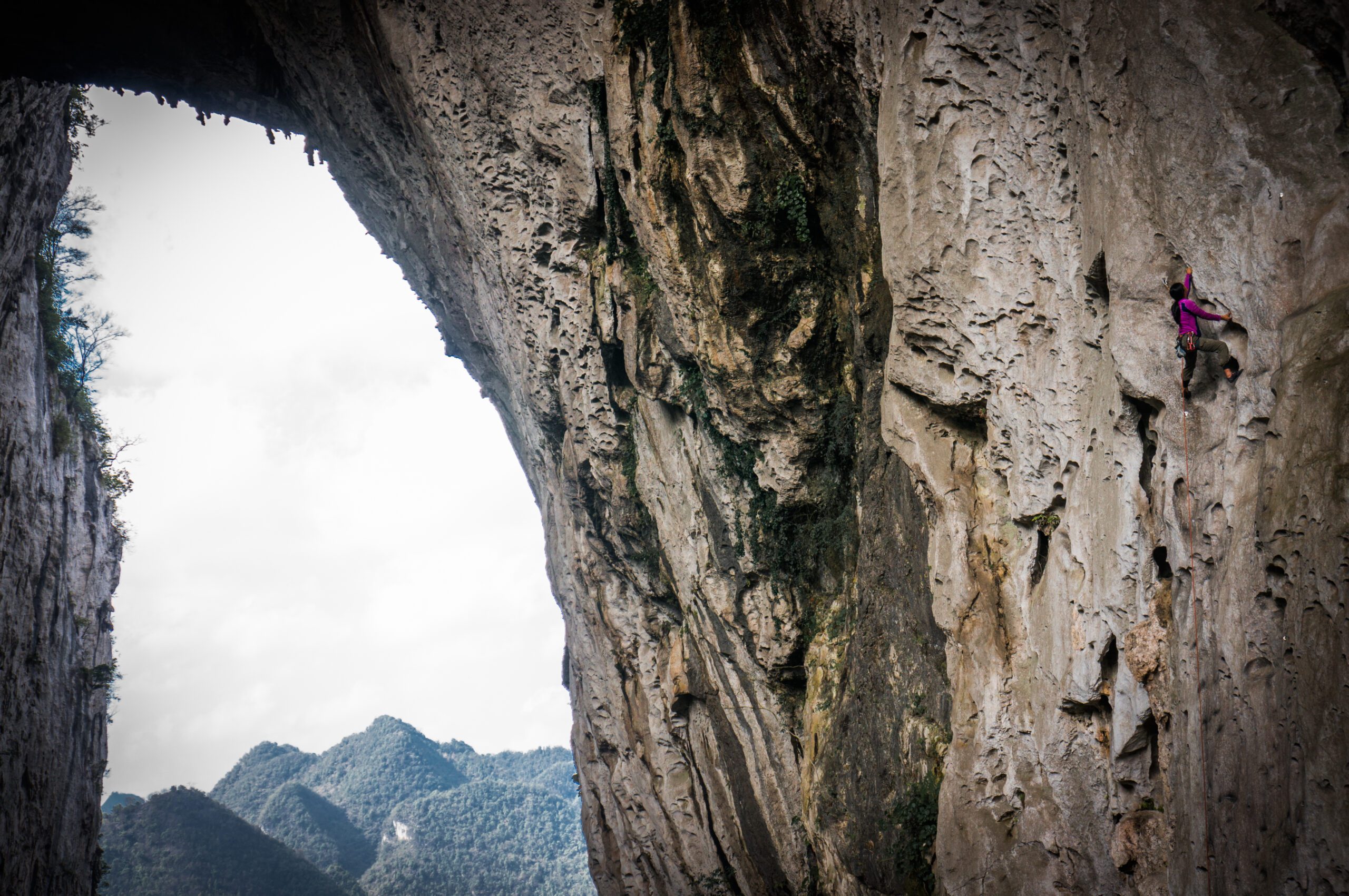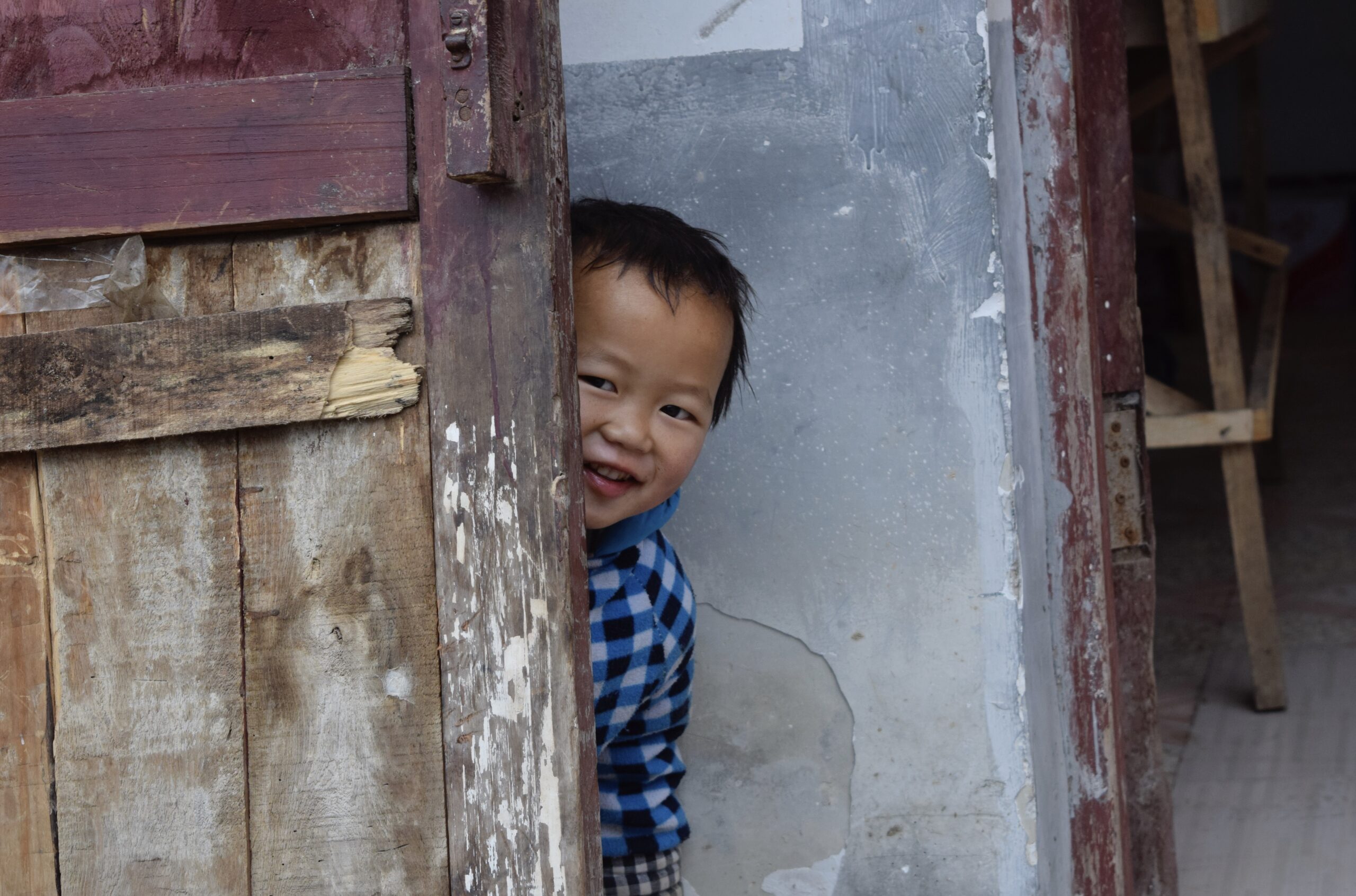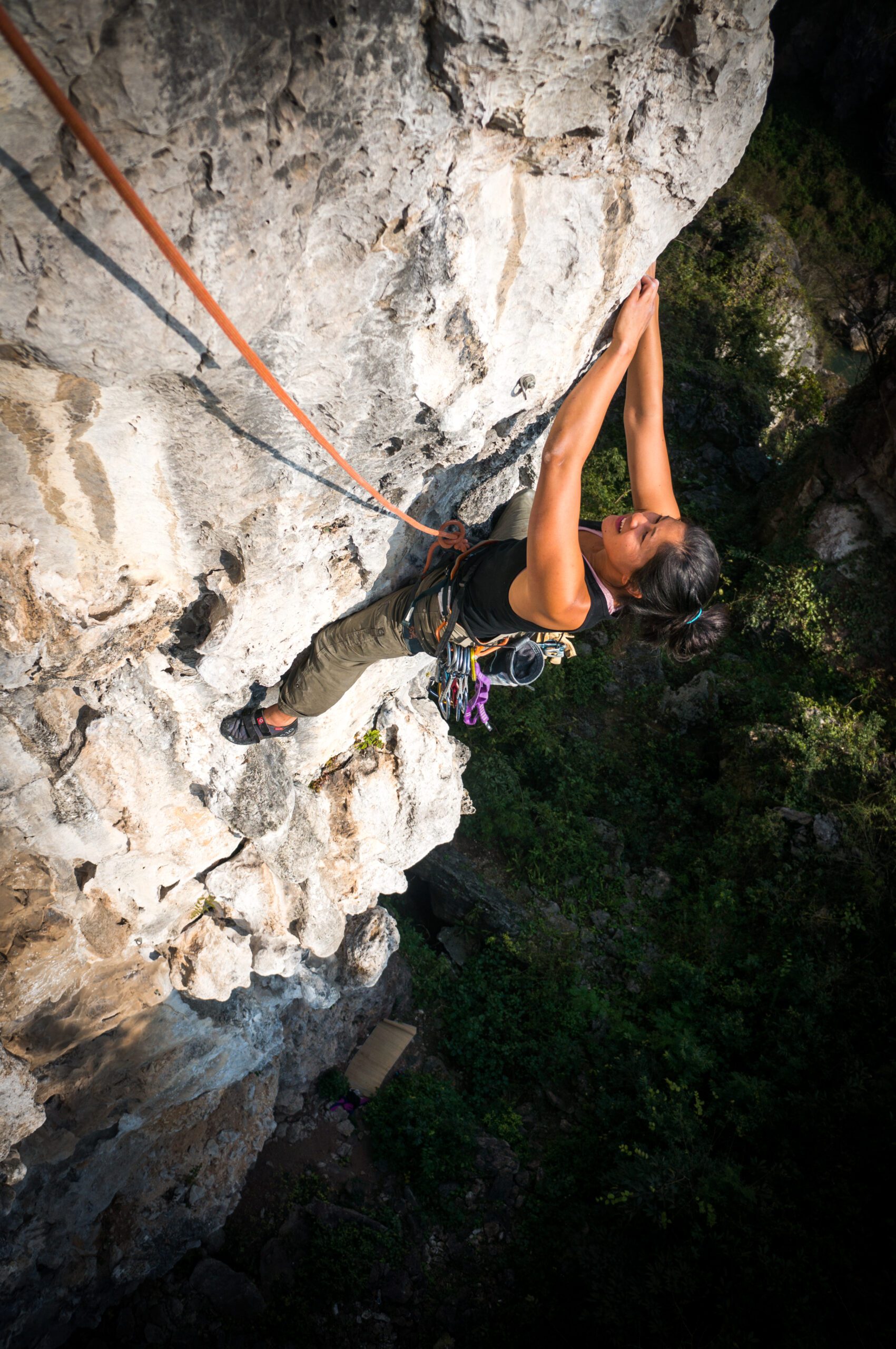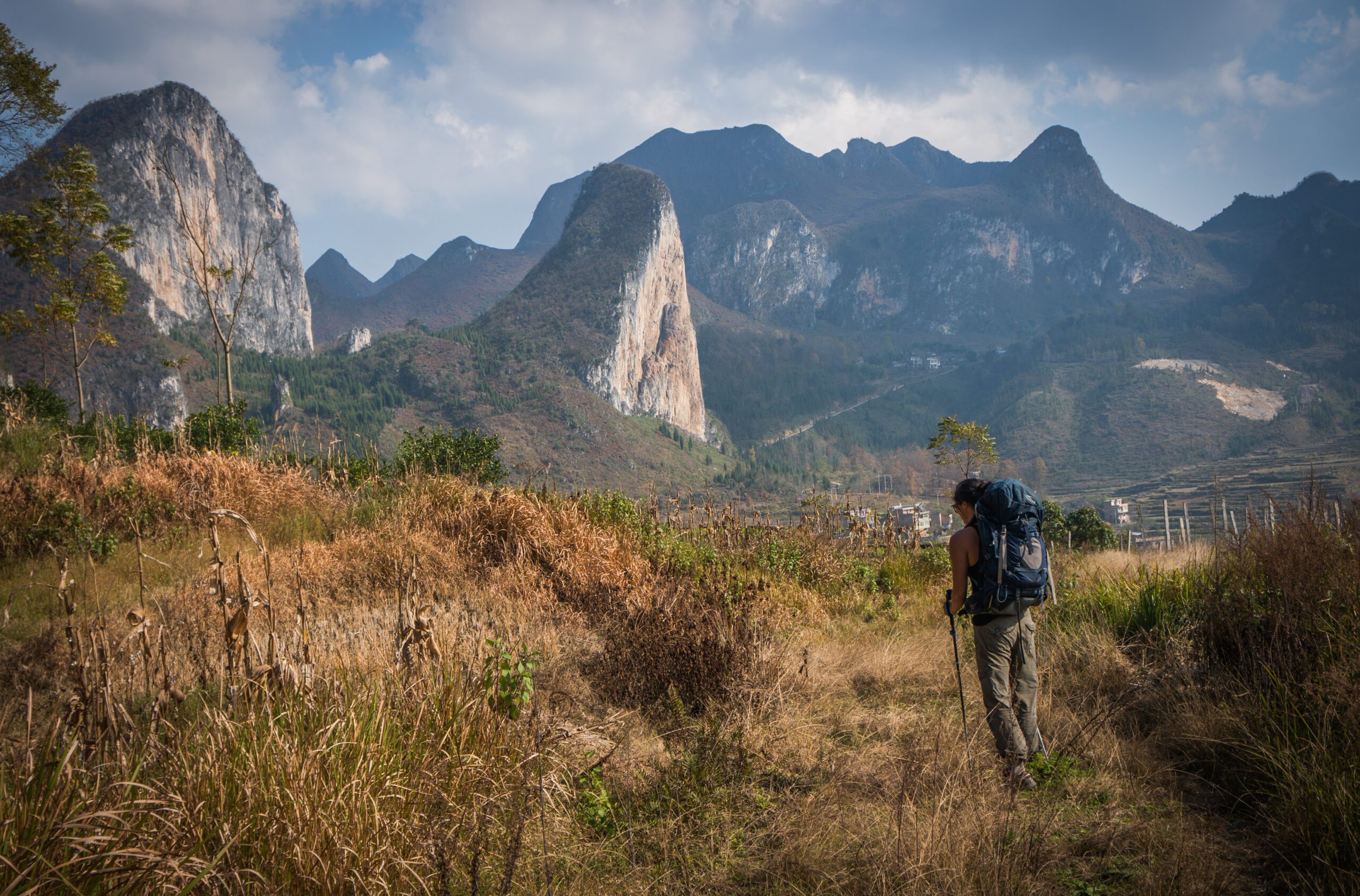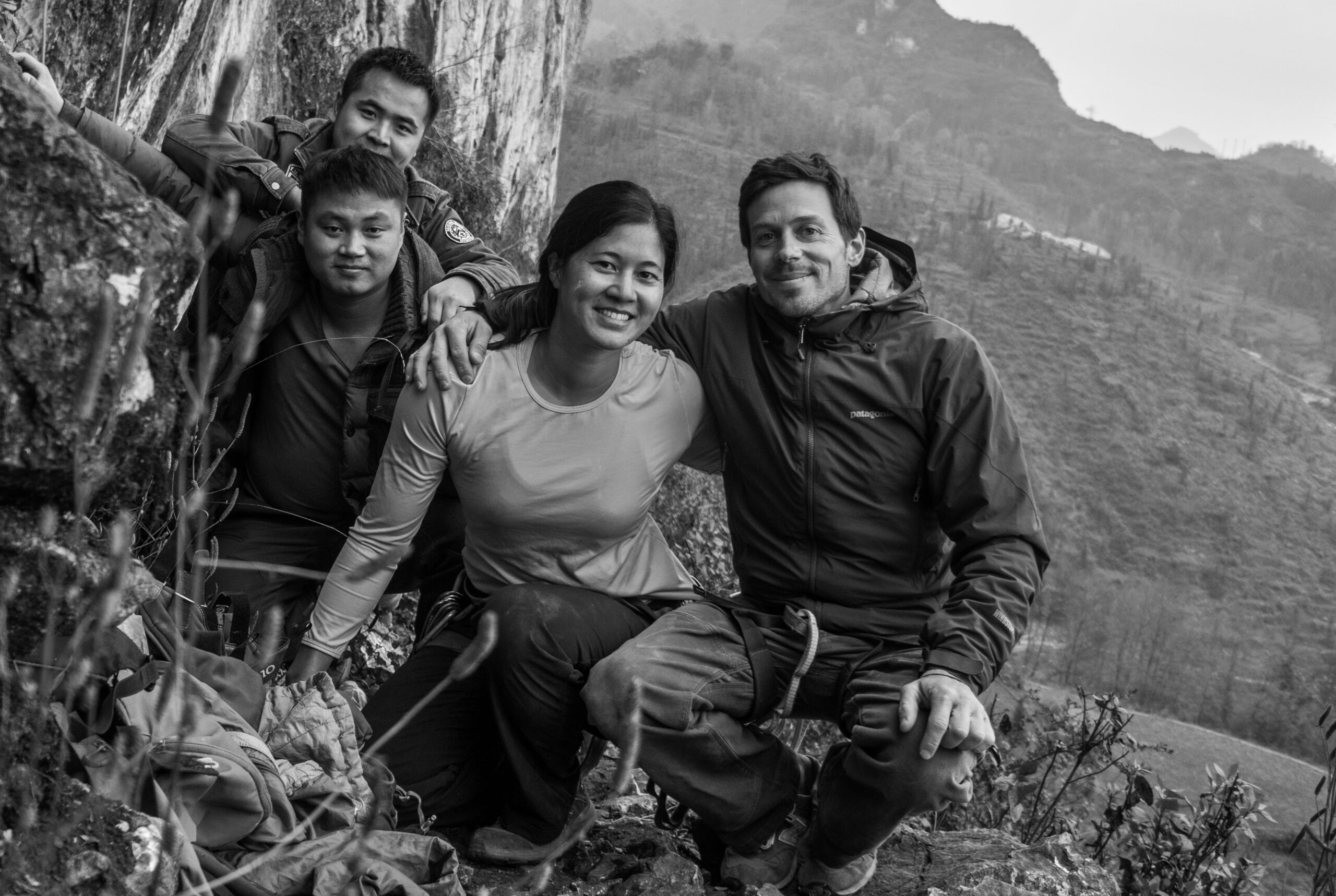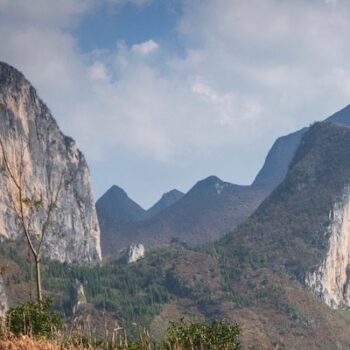
In January 2016, my husband, Josh, and I are in Gêtu Valley, China, on a rock-climbing trip. We were told that in January, it would be too rainy to climb in Gêtu, but for the last week, we’ve been outside in short-sleeve shirts. We walk along a sparsely trafficked road, carrying large packs of gear. The sun shines across the pastoral valley over the steep terraced fields and flowing, clear river. I’m amazed that in such a beautiful place, we’re the only travelers staying in the village. Behind us, a car honks.
“Hello!” shouts a man in Mandarin. He has a round face, pale unblemished skin, in his early thirties, and drives a new orange sedan. “Are you rock climbers?”
I minored in Mandarin in college and say, “We’re heading up the road to climb.”
“I will give you a ride,” he insists.
For a moment, I ponder: is it ever safe to jump into a stranger’s car? But I open the door and find a baby sock tucked in the crease of the seat. This guy’s a new dad.
The man turns around and smiles, “Where are you from?”
As a Chinese-American, I’m used to being asked this question in China. “I am a huaqiao, born in the America.”
He eyes me in his rearview mirror. “But where are your parents from?”
Although both of my parents are Chinese, I’m often told that I don’t look Chinese. I’m 5’10 with broad swimmer’s shoulders, and have Asian-shaped eyes that are larger than most Asians. I can speak Mandarin and Cantonese, but I learned both dialects after I was eighteen and have never pronounced either language with the proper tones or grammar. I tell him that my parents are from Hong Kong.
“What luck to find an American who can speak Chinese!”
He tells me to call him Xiao Wei, Little Wei. I tell him my name is Chellis and my husband’s name is Josh, but I might as well have asked him to recite the Greek alphabet.
We turn the corner, pull into a narrow paved road and arrive at Oliver’s Crag, a 50-meter limestone cliff right off the main street.
I assume he’s going to drop us off, wish us luck, and speed away. But instead Little Wei slams on his brakes, turns off the ignition, and says, “I will climb, too.”
He jumps out of the car and opens his trunk. Inside, he has a brand new hiking pack, glistening red rope, blue unused harness, and climbing shoes connected with a sales tag. His gear, which he bought online without any guidance, is mainly used for rope access work, not recreational climbing. It’s as if he’s been driving down this road for months with a trunk full of climbing gear, just waiting for the opportunity to pick up two foreign climbers.
“This is my first time climbing,” he confesses, as if we couldn’t tell.
*
Although I’m new to climbing, (Josh taught me three years ago), I’ve been traveling to China since 1999, when I first came out here as a foreign exchange student. I led a protective upbringing, born in a small town in Oregon, attended a small college in Ohio; living in China was, to say the least, the place where I first learned to be curious about the world. Since college, I returned to teach English in Guangzhou for a year, and then worked in Chinese business in book publishing and movie marketing. The last time I was in China, I was in Beijing for a photo shoot with Jackie Chan.
I now taught writing at a community college and no longer worked in Chinese business, but I was looking for a reason to return to the place that was always changing. Then I saw the Petzl RocTrip China 2011 video on YouTube, which now has nearly 1.2 millions views, and I became obsessed about climbing in Gêtu. In the video, Chris Sharma, the strongest sport climber in the world, described the 650 foot tall, limestone arch, as “…crazy. It feels like something from another planet.” The towering arches, the flowing river, the rural setting—I was hooked. I couldn’t help but imagine how strange it must have been for the local farmers, who’d never been to a large city, let alone outside China, be suddenly the host to thousands of pale-skinned, big-nosed foreigners that they’d only seen on television.
Gêtu Valley was the home of the Miao minority, who spoke Miao, instead of Mandarin, and wore embroidered navy blue shirts and colorful tall hats. The village of Gêtu remained poor with one restaurant and one cook, and a main street that was piled with garbage and construction debris. For breakfast, there was only one place to eat, at a noodle stand, sitting on the sidewalk on low plastic stools. A young Miao mother, with dark, worn skin, heated up noodles, by burning small pieces of kindling. She diced up chives and small herbs on a thick block of wood. She washed the bowls and silverware out of a large basin of water gathered from the stream. Her three-year-old son, dressed in pants with holes and patches, played hide-and-seek among the construction rubble. She spent twenty minutes making us noodles and scrambled eggs, and we paid her $1 for the meal.
In contrast, five minutes past the noodle stand, there was a new, strip mall-sized, tourist center with glass windows and fake marble floors, furnished with glossy, uncomfortable wooden furniture. Ever since the 2011 Petzl RocTrip, the Chinese government had made massive and over-the-top upgrades to push the recently declared “Gêtu Valley National Park” as an international tourist destination. Per typical Chinese fashion, the building was haphazardly constructed and tacky. The expansive parking lot was vacant, but had enough space for fifty to sixty tour buses. A sign outside the empty building projected the government’s plan, which was to create a villa for tourists to dine in and name-brand stores for travelers to shop at.
On the first day we arrived, we entered the park and walked along a recently paved, asphalt road under a series of cliché Chinese archways. We took a small motorboat across the river, and climbed up 1,000 steps, made of a wood-patterned laminate and protected by sturdy steel railings. The stairway, which was completed in 2014, meandered through a limestone arch and then to the top arch, which was filled with a huge concrete slab housing a vacant cafeteria. We only saw ten Chinese tourists while we were there, but the area had been built out to accommodate thousands of potential visitors. The few Chinese tourists that were there shrieked from the top of their lungs, because a sign instructed them to “shout to the heavens!” The trail meandered through a valley, down towards the 650-foot limestone arch, but, to my shock, the only way to continue on this trail was to take one of the two glass elevators. The elevator shaft was embedded in the limestone, surrounded by fake green vines. We zipped rapidly down the cave to another walkway, which looped down to the river. In the past, the only way to enter The Great Arch was by boat, but now, we could leave on a blue and white walkway that floated on water, like a child’s toy.
The extensive plastic walkway, empty cafeteria, glass elevator, and projected shopping complex all felt ridiculously out of place in an area that was already so naturally beautiful. Why would a 650-foot limestone arch that could only be described as “something from another planet” need to be covered with plastic green vines?
Later on our trip, we ran into a Canadian couple in Liming, China, near the Tibetan border, who had spent five weeks climbing in Gêtu Valley in 2013. They told us that after the Petzl trip, the Chinese government, in their push to promote the area for climbing tourism, offered a farmer $10,000 for land near the park entrance. The farmer organized a protest, not wanting to sell the land that had been in his family for generations, and he was immediately arrested. The government took the property anyway, and built four concrete buildings intended to house tourists. The builders hadn’t consulted the farmers about the local ecology, and the seasonal rains quickly flooded the new buildings. Josh and I had noticed the freshly constructed buildings across from the hostel, which stood empty, the windows wide open. Each unit had a new air conditioning unit. The windows and siding were new although already deteriorating. Even though the government had forced a farmer to vacant this land, it was clear that nobody but the birds had ever occupied these rooms.
*
The day before we leave, with no working phone to reach us, Little Wei wakes us up with a knock on our hostel door. Four days prior, when he had picked us up on the side of the road, he had climbed half a route before giving up to pick up his wife, sister-in-law, two children, and five pounds of mandarins to snack on. We learned that Little Wei was thirty-two-years-old and a supervisor at a real estate development company. Unlike the Miaos in the village, who had dark skin and used their hands to work in construction or farming, Little Wei described himself as a “fake Miao,” ethnically Miao, but unable to speak the local dialect. He claimed that prior to this office job, he loved to play sports, but now, “I am too busy and have grown fat.” He’d pat his round belly, surprised by the sudden weight gain.
When I open the door drowsily, he looks away embarrassed, but asks, “Would you like to climb with us today?” Little Wei has invited his co-worker, Little Chen, to join us.
One of the many joys of travel is to connect with locals in a shared activity, but this is the first time we’ve been asked to teach complete beginners how to climb. This leads into a heated debate between Josh and me. I, as the newer climber, argue that we should take them top roping, which means the climbing rope will always be safely anchored above them. This will give them the experience of rock climbing, but not give them enough tools to hurt themselves. Josh, the experienced climber, argues that we need to teach them everything about sport climbing, because when we leave, they will climb anyway. Josh wants to teach them techniques that have taken me two years to semi-master: how to tie an eight knot; how to belay with a grigri; how to properly lead climb without black clipping, z-clipping, hooking a foot behind the rope; how to clean an anchor; and all the while climbing in an area that doesn’t have a route easier than a 5.8 grade. To top this all off, I have to translate these lessons into Mandarin, a language I learned in college and speak far from fluently.
Josh selects some easy-to-moderate routes on the Pussa Yan crag, which coincidentally means “Mother Superior Protector” in Miao. This 180-meter high, triangular-shaped rock is across the road from where we were before and a fifteen-minute walk up the hill. While hiking up the trail, carrying a case of Thai Red Bulls, Little Wei brags that he’s not afraid of heights. In his job, he works in tall building, and he spent his childhood running around these mountains. His confidence with being up high is what initiated his desire to learn to rock climb.
We find a route at the far left of the crag, “Slab Beginning,” a low-angled 5.9 route with a small ledge at the anchor. I drop my pack and take a breath. I look behind me at the rays peaking between the wisps of clouds and shining upon the green farmlands creating patches of glowing light. From here, I can’t see the road or any homes, just terraced fields and snaking waterways.
I tell Little Wei and Little Chen that we’re going to climb the easiest route in the area, but it’s clear that they don’t need my assurance. They’re already downing Thai Red Bulls.
Little Wei reaches into his bag and pulls out a forearm-sized metal device connected to a large metal clamp. “What’s this?”
Josh, who has been climbing for twenty years and built cell phone towers for seven, has never seen a contraption like this before. He theorizes it’s a lowering device used for rapelling.
I translate, “That’s for work.”
Little Wei holds up a ten-foot long, fluorescent green rope with fixed steel carabiners and folded webbing intertwined in a plastic sheath. “And this?”
Josh says it’s a shock-absorbing lanyard, intended to lessen the blow if a worker falls from great heights.
I translate, “That’s for work, too.”
Little Wei nods his head. He doesn’t appear to be upset, although he has spent over $400 on the wrong gear.
We take out our 70-meter rope, two harnesses, two pairs of shoes, one belay device, and twenty quickdraws.
Little Wei points to our quickdraws. “Why do you have so many?” He shows us that he had only bought one, which shines like a polished spoon.
I explain that climbers need at least ten to twenty quickdraws to climb to the top of a route, because one quick draw goes into one bolt. I don’t know how to say “bolt” in Mandarin, so I point to the wall where the bolts are.
Little Chen looks up and notices the bolts that make a trail to the top. He asks, “Does this mean that other climbers have been here before?”
When learning how to climb in the States, there are many opportunities to learn the basics—Internet forums, books with instructions, climbing gyms to practice. But here, these guys have zero mentors. Nobody to tell them what gear to buy; nobody to tell them the levels of the routes; nobody to make sure they’re climbing safely. They imagine rock climbing to be like hiking up a hill—just pick a spot and go.
Little Wei takes a picture of our grigri and quickdraws with his smartphone and says, “I will go online and buy everything tonight.” Twenty quickdraws and a grigri will set him back $500, but this doesn’t alarm him. He lights up a cigarette and smiles.
As the day progresses, Josh pushes Little Wei and Little Chen to learn new skills. They tie a Figure 8 Follow-Through Knot, which connects the climber to the rope. I guide their rope through the loop, but they keep messing it up on the follow-through. Little Wei records the process with his smartphone and promises to study it when he goes home.
When Little Chen climbs on top rope, Josh insists that Little Wei belay him.
I have my doubts, but Josh tells me not to worry; he has his hand on the rope for backup.
When the two have both top roped the route, Josh encourages them to lead climb.
I’ve been climbing for two and a half years and just started lead climbing, which still intimidates me. Lead climbing means ascending the route while periodically stopping to clip into a bolt. When a lead climber falls, they fall farther, but that also depends on if they clipped in correctly and how closely the belayer is watching them. Sport climbing is safe when it’s done with someone like Josh, but what about these two who are still unable to tie a basic 8-Knot? I worry that when they fall, they’ll hit the ground.
I say to Josh, “We’re pushing them too fast.”
Josh reminds me that we’re leaving tomorrow and they’re going to climb on their own anyway. The safest way for them to climb is to learn how to get to the top and come down, as if we aren’t there.
We continue to debate the topic further—he’s growing impatient with me—and I realize that we’re not talking about climbing anymore. As the new climber, I don’t fully trust the gear and my skills; I’m afraid of falling and want to protect those less experienced than me. Similarly, China’s Communist Party was established in 1949 and is new to governing. They don’t know the best ways to encourage the growth of a civilization. The Chinese government blocks Google, Facebook, Twitter, and YouTube, because they think they’re protecting the people by keeping them safely in the dark. They create long glass walkways and plastic bridges in caves assuming that tourists don’t know how to enjoy a natural wonder without contrived attractions. The less the people know, the less chance they’ll have to hurt themselves. The Chinese government has institutionalized the concept of “ignorance is bliss.”
On the last route of the day, due to Josh’s persistence, Little Wei climbs on lead, while Little Chen belays him. He starts the route confidently. He just saw Josh and me climb the route effortlessly, and he had climbed the route himself on top rope. He reaches the crux near the top, where he must stick his hand into a small crack and place his foot high onto a ledge. He becomes aware that he’s above the bolt, and if he falls, he’s not going to be caught right away. His arms begin to shake. He shouts down to Little Chen, “I can’t do it!”
Little Chen shouts back up to him, “Keep trying!”
Little Wei says, “I’m not strong enough!”
Little Chen says, “Don’t give up.”
Meanwhile I’m so afraid for them, I’m making myself nauseous. Logically, I know that they are safe—the rope is there to catch them, the bolts are securely placed in the wall, and Josh has his hand on the rope for backup. But I hate to see them so scared. I hate hearing Little Chen’s uncertainty, and I hate hearing Little Wei’s voice tremble with fear.
Little Wei releases the rock. He doesn’t drop far, but he screams.
The fall jerks Little Chen towards the rock. His hand is firmly on the brake, like we’d taught him. When he realizes that he and the grigri had caught Little Wei safely, he digs his heels into the dirt, and shouts, “You’re safe! Now keep climbing!”
Little Wei fell and Little Chen caught him. This simple exchange that occurs all the time among climbers makes me unbelievable excited. They’re safe.
I clap my hands, and say, “Good job, Little Chen. You did a very good job.”
When we first arrived at the crag, they were confident about their climbing skills, because they knew very little about the sport. Now they’ve experienced the way the forearms tremble when overworked, what it feels like to fall ten feet, and how important it is to have a climbing partner who knows how to belay. I wanted to protect them not just from the dangers of climbing, but also from the fears of climbing—now I realize that this healthy fear is what may protect them when we’re gone. I’m suddenly appreciative that Josh was so insistent on throwing them into the deep end.
After we’re done climbing, Little Wei takes us back to our hostel and instructs us to pack up our things. On the way out, he gives the Miao hostel owner his phone number, and says, “Give me a call if any other climbers stay here.”
Little Wei brings us to his home and cooks us a spicy pork hot pot. Between his friends and family members there are two large tables of eaters. To pass the time, the men play drinking games with Josh, and we give everyone, all the children and adults, American names that match their Chinese ones. Little Wei, or William, pays for our hotel room, which is in the nicest place we stay on our entire trip. He takes us out for a traditional Guizhou breakfast, and drives us to the bus station, where Little Chen buys our bus tickets. I thought that since Little Wei had effortlessly spent $1,000 on climbing gear, he was wealthy, a member of China’s super-rich. But he lives with his two kids and wife in a modest apartment. There are piles of garbage in his unlit stairwell. Without heat in his home, we must warm our hands on the hot pot table. But Little Wei, unlike the Miao mother who cooks noodles for a $1 a bowl, has enough disposable income to afford two children, a new car, and to start new hobbies.
As we walk to the bus station, I tell Little Wei, “This is Josh’s first time in China.”
“Really?” Little Wei beams. He’s dressed in fashionable jeans, a V-neck t-shirt, and a coat that resembles a letterman jacket. “If I have represented China in a positive way, then maybe” he gives Josh a thumbs up, “he will come back many more times.”
Little Wei looks at Josh, as I translate his words. Josh smiles, returns the thumbs up, and Little Wei picks up his gait swinging his arms youthfully.
I leave Gêtu Valley with a mix of feelings. I’m appreciative of my experience—climbing the majestic limestone arches, befriending Little Wei and his family, but I also can’t help but mourn the area’s future development. The next time I return to Gêtu, the place will be different—more tourists in the caves shrieking to the heavens, more plastic vines covering unique geological features, more name-brand shops with clothes and purses to sell. The 2011 Petzl RocTrip attracts a group of people with good intentions, myself included, but I wonder, if the founders had known how aggressively the Chinese government would progress tourism, would they have come?
We reach the security entrance at the bus station and are about to head our separate ways.
I tell Little Wei, “In America, friends hug.” I demonstrate this by giving Josh a casual hug with distance between our bodies and a two-hand pat on the back.
This makes Little Wei nervous. He’s probably seen hugging in American movies, and he probably hugs his wife in private, but hugs are not a social exchange shared among friends in China. He blinks his eyes. He realizes something. He’s fallen and lived to tell the tale. And he goes for it. His arms fly out suddenly. He grabs Josh’s body in a rush, and then releases, flinging his arms out and pushing Josh away. He has a huge grin on his face.
In our two days together, I have grown quite fond of Little Wei. It’s my turn for a hug, and I open my arms, but instead of reciprocating, Little Wei grabs my hand in a firm shake.
I’ve crossed the Chinese border over a dozen times since 1999. I have my opinions on what China’s progress has ruined, and yet, every time I return I’m surprised by a new, positive experience. Little Wei had picked us up off the road in his own car, brought us to his home to feed us copious amounts of food, and is an example of a Chinese person who has gained wealth, but has not forgotten how to be kind. Little Wei had decided that even though he had no knowledge of climbing, and although he knew of nobody else who climbed, he would learn to do it anyway. And it’s this boldness and ambition to try new things that compels him to do what I never would’ve expected: he shrugs his shoulders, retracts his hand, and gives me an awkward hug, too. Perhaps progress isn’t all bad.
***
Photographs provided courtesy of author. Photographs of The Great Arch, the author climbing, and the Gêtu Valley taken by Joshua C. Hood.

